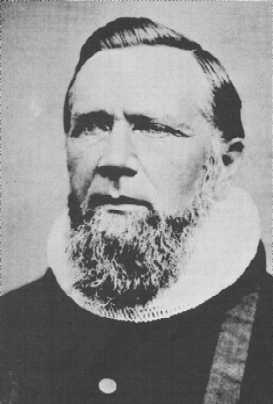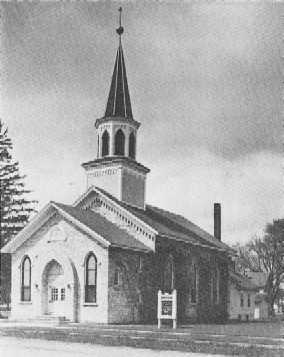Biography of
Rev. Claus Lauritz Clausen
Let this be recorded for a generation to come,
so that a people yet unborn may praise the Lord.Psalm 102
It is logical that the history of St. Olaf Lutheran Church should begin with a short biography of Rev. C.L. Clausen. His name was woven into the early history of the Norwegian Lutherans in the United States.
Claus Laurits Clausen was born on the island of Aeroe, Denmark, on November 3, 1820. A pious grandmother guided his religious instruction in Luther's Small Catechism. He studied law for three years before deciding that this was not to be his calling.
Burdened by a sense of guilt after he suffered some gambling losses, he turned to a Christian friend, Martin Bonnesen, who was instrumental in bringing Clausen to a personal faith in Christ.

C.L. Clausen Lacking funds to study theology, Clausen began to teach. Tuberculosis interrupted his career, and he took a walking trip in Norway. On this trip he met T.O. Bache of Drammen, who had a son, Soren, a settler in Muskego, Wisconsin. Informed that this Muskego settlement lacked a trained religious leader--the young teacher volunteered for the task.
Clausen returned to Denmark and spent the winter preparing himself for the new venture. In the autumn of 1842 he married Martha Rasmussen. It is said that Martha wrote the hymn, "And Now We Must Bid One Another Farewell," on the occasion of parting from parents and family.
The voyage to America aboard the German vessel 'Johanna' lasted two months. The twenty-three year old teacher and his bride arrived at Muskego, Racine County, Wisconsin on August 6, 1843.
In the Muskego settlement the hayloft of the barn of Even Heg was the gathering place for worship. Clausen immediately saw the need of an ordained Minister as many children were still unbaptized, young people of eighteen to twenty years old were unconfirmed and most of the settlers had not received Holy Communion since leaving Norway.
On September 3 seventy members of the settlement signed a formal petition to Rev. L.F.E. Krause; a German Lutheran pastor near Milwaukee, expressing their desire to have "the Reverend Pastor" Krause ordain Clausen. This was followed ten days later by an historic Letter of Call. September 13, 1843, the date of this first Letter of Call from a local congregation, became the birth date of the Norwegian Lutheran Church in America.
On Wednesday, October 18, 1843, in the haymow sanctuary at Muskego, Pastor L.F.E. Krause, German, ordained the 23-year-old C.L. Clausen, a Dane, to serve a Norwegian congregation.
Clausen went about his tasks with a deep sense of pastoral responsibility. Almost every family had been visited by plague, a malarial fever, Clausen's first funeral was the day following his ordination. In November, 1843 he conducted thirty-two funerals, eight on one day. On January 1, 1844 there were seventeen burials, the record for a single day.
Late in November, 1843 the Muskego congregation authorized the erection of a church building, the first Norwegian Lutheran church in America. Dedicated in March, 1843 the building served the church until 1869. The old log church was sold to a farmer who used it for his hogs. In 1904
FIRST LUTHERAN CHURCH, ST. ANSGAR, IOWA
Old Muskego Church was moved to the campus of Luther Theological Seminary where it has become the shrine of Norwegian-American Lutheranism.
Martha Clausen died in 1846. Their one son, M.N. Clausen, was later to be the city engineer of Austin. Later Pastor Clausen was to marry Bergetha Peterson, and they would be the parents of four more sons.
The western settlements near Muskego were a vast mission field to which Clausen's pastoral concern directed him. He did not attempt formal organization, but did preach and administer the sacraments.
During this period Pastor Clausen tried to establish a relationship with Elling Eielsen, the follower of Hans Nielsen Hauge. Eielsen was not ready to accept Clausen's hand of friendship and went his separate way. In 1846 Eielsen established the Hauge synod.
Pastor Clausen was also influenced by the dominant personality of Rev. J.W.C. Dietrichson, the first to come as an ordained pastor from the state church in Norway. As many of the settlers felt that Dietrichson represented the "high church" and the official class from Norway, he experienced considerable opposition.
In the first years of his ministry Pastor Clausen was haunted by a feeling of inadequacy because he had not received formal theological education.
In 1846 Pastor Clausen left Muskego for Rock Prairie, now known as Luther Valley, Wisconsin. There, in January, 1851, an assembly was held to organize a synod to be known as the "Norwegian Evangelical Lutheran Church in America". Clausen was the first superintendent. The organization was also under the guidance of the two other pastors in the synod, H.A. Stud and A.C. Preus.
Pastor Clausen visited Iowa in 1851 and preached the first Scandinavian Lutheran sermon in that state.
In 1853 Pastor Clausen assumed the role of colonizer. He led a caravan of seventy-five settlers in thirty covered wagons to
northern Iowa. The covered wagons were pulled by oxen. They chose for their settlement a site at the juncture of Cedar River and a stream which Clausen called Deer Creek. The site he named St. Ansgar, meaning "God's spear." They built a church of stone which remains in 1967 as the sanctuary of the First Lutheran Church, St. Ansgar, Iowa.

First Lutheran Church,
St. Ansgar, IowaFrom St. Ansgar Rev. Clausen served the people in the neighboring settlements. He also made missionary trips throughout a territory extending two hundred miles east and west and seventy five miles north and south. He founded twenty-one congregations, one of which was St. Olaf Lutheran Church, Austin. On this basis First Lutheran Church, St. Ansgar, Iowa has a claim to be the mother church of St. O1af.
We quote now from a book published in 1890, American Lutheran Biographies, By Rev. J.C. Jensson.
"When the Civi1 war broke out in 1861 Rev. Clausen enlisted as chaplain in the famous 15th Wisconsin Regiment, under Colonel Hegg. (Colonel Hegg had been one of the leaders in Clausen's congregation at Muskego) During the bombardment of Island No. 10 a mortar was accidentally fired off over his head. This gave his nerves a shock from the effects of which he never fully recovered."
"Simultaneously with the opening of the Civil War a controversy opened in the Norwegian Synod over the question of whether or not slavery be sin, in which controversy Rev. Clausen stood well nigh alone for the affirmative against the rest of the Synod. This doctrine of the majority being established as the doctrine of the Synod, together with dissentions on other important questions, caused Rev. Clausen in 1868 to leave the Norwegian Synod, and led to the organization of another Lutheran church body, "The Norwegian-Danish Conference, with Rev. Clausen as its first executive. This interesting chapter of church history is dealt with in a book entitled 'Gjenmalet,' by Rev. Clausen."
Continuing his missionary work from his St. Ansgar home, it was during this period that Pastor Clausen preached and administered the sacraments at intervals in the Austin and Blooming Prairie area.
On October 28, 1867, he organized the St. Olaf Lutheran Church. His work throughout this area continued until he suffered a stroke in 1872.
Because of his health Rev. Clausen settled in Virginia, thirty miles north of Richmond on the Rappahannock River. In 1875 he took charge of the Scandinavian Lutheran Church in Philadelphia, Pennsylvania, and served there until the fall of 1876. This occurred in the United States' centennial year.
C.L.CLAUSEN'S FIRST HOME IN AUSTIN
After recovering his health, he came back in 1878 and took up his home in Blooming Prairie. He served churches at Austin, Little Cedar, Red Oak
Grove and Blooming Prairie until he suffered his second stroke in 1885. This forced his retirement.
On May 21, 1885 the Austin Democrat noted that "Rev. C.L. Clausen has moved from Blooming Prairie and has purchased the Peter Nelson property in second ward."
Quoting again from the 1890 edition of American Lutheran Biographies we find that, "Through the liberality of Uncle Sam, he passes his old age comfortably cared for in Austin, Minnesota." We interpret this as meaning that he had a Civil War disability pension.
Bergetha Clausen died in 1887. Shortly thereafter there was another news item in the Austin Democrat, "Rev. Clausen left Austin today for Port Townsend, Washington. He will spend the winter in the west where he goes in search of health. His son accompanied him, but will return soon."
In 1892 Pastor Clausen suffered his third and final stroke. He died on Feb. 20 at the residence of his son, C.W. Clausen, at Pearson's Landing, Washington. His funeral was held in St. Olaf Lutheran Church, Austin. At his funeral a fellow clergyman gave a poetic tribute to Pastor Clausen:
And here among our frontier group,
You soon assumed the shepherd role.Though hardly an epic of poetry these lines emphasize Pastor Clausen's outstanding characteristic, a shepherd's instinct for the care and concern of his people.
His impact was made on all who associated with him. His obituary in the Mower County Transcript had the following tribute: "He was bishop in all but name to a vast region including Mower County. The presence of a well informed, cultured gentleman contributed much to keep them in connection with the best of their past lives. Those who realize the importance of what this frontier missionary has done for the well being of our community among the English speaking population will best appreciate what Rev. C.L. Clausen has done for another element of our population. Mr. Clausen's life has been an active and useful one. He was the leader to guide his people at all times and in all places. No wonder they looked upon him as a beloved friend and revered him as an honored father."
The story of Clausen is also a part of the history of the Middle West. He is written up in the state histories of Illinois, Wisconsin, Iowa and Minnesota. During his lifetime he served as Justice of Peace, a member of the Iowa legislature and as a Commissioner of Immigration. He was a delegate to the Paris Exposition, and was a member of the Scandinavian Lutheran Educational Society which was instrumental in establishing the first seat of Scandinavian Literature and Languages at a state university.
Claus L. and Bergetha Clausen are buried at Oakwood Cemetery, Austin.
Larger Versions of Photos
Original, un-retouched Photo of Claus Clausen, 250 K bytes
Original, un-retouched Photo of First Lutheran, 170 K bytes
Original, un-retouched Photo of His home in Austin, 170 K bytes
Transcribed by Kathy McAlister Pike, Aug. 2004; from the St. Olaf's Centennial book, of St. Olaf Lutheran Church, Austin, Minnesota, dated 1967.
Webization by Kermit L. Kittleson 8/8/2004
Updated by Kermit L. Kittleson 5/12/2005